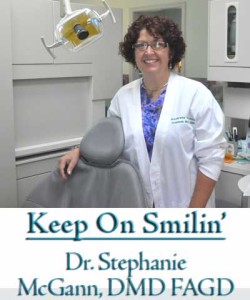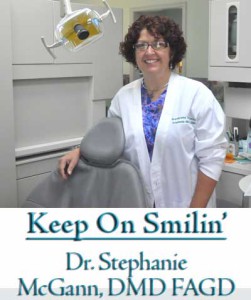Knowing your plan and your options can save you money and keep you healthier
By Dr. Stephanie McGann, DMD, FAGD, Columnist, The Times
 If you have dental benefits, congratulations! – You’re one of the lucky ones. Many folks have no benefits. Too many of us have very little idea how our plans work and how much they actually cover. This is unfortunate and often works to the benefit of the insurance carriers themselves. Their job (being realistic here) is to make money for their shareholders. The fewer claims they actually pay the more profit they can report.
If you have dental benefits, congratulations! – You’re one of the lucky ones. Many folks have no benefits. Too many of us have very little idea how our plans work and how much they actually cover. This is unfortunate and often works to the benefit of the insurance carriers themselves. Their job (being realistic here) is to make money for their shareholders. The fewer claims they actually pay the more profit they can report.
In order to maximize your dental benefits it is important to first know what type of dental coverage you have. There are 4 major types of dental benefits each has limitations to the benefits they provide. While no plan covers everything, some may be better suited for you and your family.
Traditional indemnity plan:
This plan allows a patient to visit the provider of their choice. The plan pays for services based on the service type and a percentage of the provider’s fee. In some cases they use arbitrary amounts (former known as UCR) to determine the amount they pay. With these plans the patient pays the provider the difference between the actual fee and insurance payment.
PPO – Preferred Provider Organization Plans:
This is the “new” indemnity or Fee for Service plan. It usually comes with two options.
Option 1 — Out-Of-Network: A subscriber can visit the provider of his choice and have a traditional plan. The plan pays based on a percentage and subscriber (patient) pays the difference.
Option 2 — In-Network: In this situation the dentist has signed an agreement with a carrier to a set pre-determined fee schedule. The provider bills the insurance carrier their regular fee, the carriers pays the difference and determines the patient co-pay. The provider must write off the difference between their standard fee and the contracted fee schedule. Using this option can save patient money if a provider of their choice is on the list, but it can limit your options. While no insurance covers everything, many PPO’s offer reduced fees for services that normally are not covered by traditional dental insurance, including some cosmetic dental procedures.
It is important to note that almost all PPO plans have the out-of-network option. Out of network does not always mean it costs more money.
DMO – Dental Maintenance Organizations – the dental HMO:
These plans are usually not beneficial to the patient or the provider. A patient with a DMO plan can only visit the dentist they chose when they enrolled. If they did not choose, one is chosen for them. That dentist is compensated on a capitation program — or “per head” basis. They are paid “per head” based on the number of enrollees on their “list.” These contract dentists are prepaid to provide certain services for the patients on the list. To get the most out of these plans, be sure to schedule appointments well in advance.
Direct Reimbursement (DR):
A DR plan is the least complicated and most beneficial for patients. In a typical direct reimbursement plan the patient pays for their care and is reimbursed by their employer or plan administrator. In every case the employer is ultimately paying the claims – this is a benefit plan not insurance. The employer group will set maximum limits as to what an employee and their family is eligible for. Because there is usually less overhead in the DR plan patients often get better levels of benefits. It is important to check out the specifics of any plan before signing up.
There are some simple tricks to maximizing your benefits, too:
- Find out if your plan runs on a calendar year or some other date.
- Find out if you are eligible for cleanings every six months or twice yearly. (this makes a difference)
- How often does your plan cover complete (full) x-ray series?
- What is your annual maximum?
- Ask for a copy of your benefits – you pay for the coverage you are entitled to the information.
If you are eligible for cleanings twice a year, be sure to schedule two each year. If you are an every 6 months then schedule two but be sure 6 full months are between the visits. Even one day “too soon” and they won’t cover you. Please don’t ask your dentist to fudge the date, that is insurance fraud and everyone can go to jail. Most plans cover preventive services at 100%; don’t waste these valuable benefits.
Annual maximums are the max amount the carrier will pay on your behalf. These are “use it or lose it” benefits. Most plans have a $1500 max, so it is important to not put off treatment if you still have benefits remaining. Savvy patients will schedule procedures before the end of the year so they can take advantage of all of the dental dollars they are entitled too. If it’s fall and you still have benefits left, speak with your dentist and see if there are concerns that should be addressed prior to the year end. It’s often better to replace and old filling or place a crown on a cracked tooth before it becomes an emergency and ultimately more costly. Yes, it’s true; a stitch in time saves nine.
If your plan offers a participating dentist option, choose carefully and learn what the pro’s and con’s of your plan are. Not all networks are the same. Always check if a specialist is available in your area before you sign up for a plan. If you have to travel 100 miles to see a specialist your network might not be the best deal.
Don’t assume your dentist knows your plan. Each employer that offers dental benefits to their employees negotiates the specifics of the plan when they purchase it. In some larger companies they offer benefit level options. So what you have and what the person who works next to you have isn’t always the same.
What all this means? If you have benefits don’t waste them. If you don’t have benefits, talk to your dentist about ways to keep your mouth healthy and avoid costly unexpected dental problems.
Dr. Stephanie McGann is a resident of the Unionville area and along with her partner, Dr. Marie Scott, operates The Brandywine Smile Center, a family-friendly dental practice in Concordville. She is a Fellow of the Academy of General Dentistry.







We all know that the American Dental Association recommends brushing your teeth, thoroughly, twice a day and many of us have been begged by our dental hygienists to actually floss. Cosmetic dentist and Huffington Post blogger, Dr. Thomas P. Connelly, adds that a morning tongue scraping is a “huge” part of overall oral health. ‘`
Bye
<http://healthmedicinelab.com/